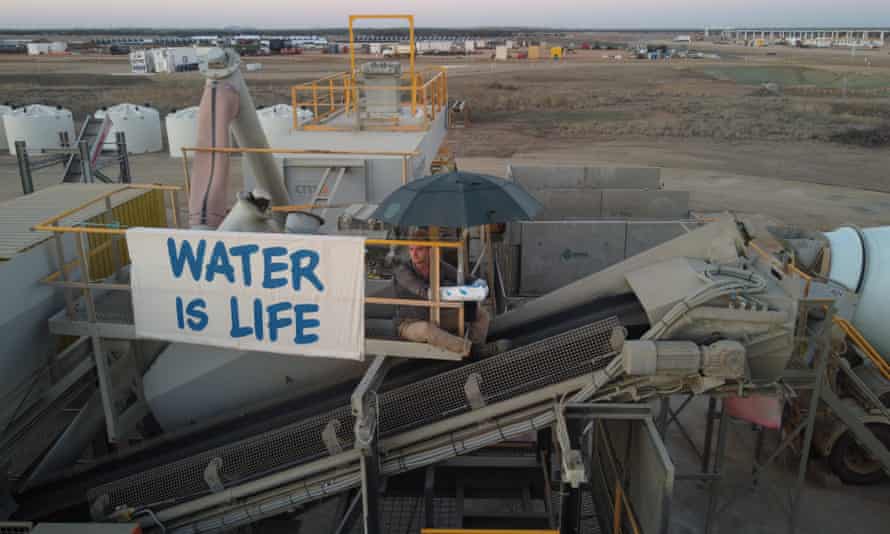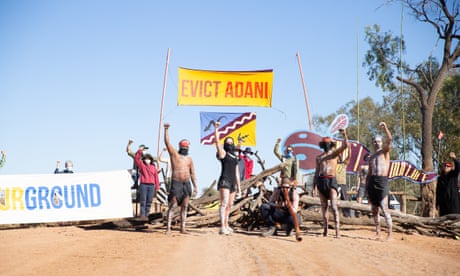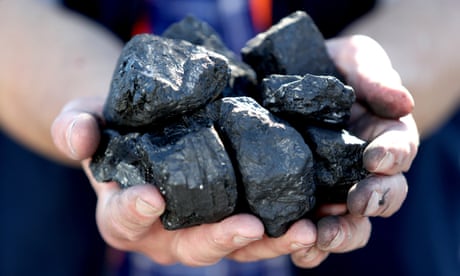Extract from The Guardian
Exclusive: Internal email reveals decision not to give ‘further clarity’ to Guardian, raising concerns about 8bn litre annual shortfall.

Protest at Adani construction site in Queensland in 2020: Internal email reveals strategy to obscure details of water plan for its Carmichael coalmine.
Last modified on Fri 25 Jun 2021 03.32 AEST
An internal email reveals Adani executives adopted a deliberate press strategy to obscure details about its plans to source large volumes of water for the Carmichael coalmine, raising concern among environmental groups and water experts about how the company intends to cover an 8bn-litre annual shortfall.
A Guardian Australia investigation has confirmed with the Queensland regulator that Adani’s only viable source of water to support mining operations at the project is “associated” groundwater, pumped from the Carmichael mine site.
But the company’s own water modelling says clearly that the anticipated volume of associated water is less than a quarter of what will be required during mining. A 2017 study, commissioned by Adani, says an external water source was “critical to the viability of the project”.
Adani’s initial water plans were thrown into turmoil last month, when the federal court overturned federal approval for the company’s North Galilee Water Scheme – a pipeline project that would have pumped up to 12.5bn litres a year from Queensland’s Suttor River.
The court found the federal government made an error when it decided not to apply the “water trigger” to carry out a more rigorous assessment of the scheme.
When asked by the Guardian where it planned to obtain water, Adani’s response included an internal email between a staff member and its Australian chief executive, Lucas Dow, which appeared to be sent in error.
“I suggest we do not give him anything more than what is already on the public record from us,” the Adani employee says.
“They are clearly struggling to work out where we are getting our water, so I don’t think we give them any further clarity.
“We will probably end up with a negative article in the Guardian, saying we are getting water through illegal sources or something similar, so it may be worth giving the regulator a heads up that this article is coming, and assuring them they are already aware of our water sources.”
Dow responded: “That’s fine.”
Guardian Australia made clear in a follow-up email it had sought the information in order to provide the public with “further clarity” about how Adani proposed to use a natural resource.
The Guardian has made no suggestion – in its questions or otherwise – that Adani is obtaining water through illegal sources.
In its official response, Adani said that the regulator – the Queensland Department of Regional Development, Manufacturing and Water – was aware of its water sources.
The department, in response to questions, said that Adani’s only relevant licence was an “associated water licence” that would allow it to extract groundwater as necessary from coal deposits.
“No application has been made to [the department] by [Adani] for any additional water source and there has been no discussions between the company and [the department] regarding additional water entitlements or other future plans regarding water use,” a department spokeswoman said.
The associated water licence has no volume limit, but allows Adani only to remove groundwater for certain purposes like “mine dewatering”, which is required to dry out coal deposits prior to extraction.
In Adani’s own modelling, the company claimed its extraction of associated water would yield 2.5bn litres a year that could be reused during mining operations. The same modelling shows up to 11bn litres a year in total required for mining use.
Environmental groups and hydrologists say that any attempts to take additional groundwater could be in breach of the licence and would put groundwater supplies and sensitive ecosystems at further risk.
Tom Crothers, a former general manager of water allocation and planning for the Queensland government, said any new source of water claimed by Adani should be subject to new modelling and assessment.
The Australian Conservation Foundation, which brought the federal court challenge against the North Galilee Water Scheme, says the decision in that case means any alternate plan must be assessed under the national water trigger.
“The Queensland and federal governments must require the company to come clean about exactly how much water it needs to build and operate its mega coalmine, where that water will come from, and what the impact will be on surface and groundwater ecosystems,” the ACF’s Gavan McFadzean said.
“The federal government should audit all Adani’s water sources to make sure they have all been assessed under the water trigger and comply with national environmental law.”
Carmel Flint, the national coordinator of Lock the Gate, said Adani’s obfuscation about its water plans had heightened concern about potential impacts on significant water sources like the Doongmabulla Springs.
“We fear attempts by Adani to obtain water it has no right to will lead to the dewatering of bores for farmers and a greater impact on underground water sources than previously predicted,” Flint said.
Adani has two current water permits that allow it to take river water, but these are only valid for use during construction of the Carmichael project – not for mining. Both permits expire later this year.
Adani holds a separate water licence for its initial plan to pump water from the Suttor River. That plan is no longer viable unless Adani appeals the court decision, or the environment minister, Sussan Ley, makes a new determination. Adani did not respond to a question about whether it intended to appeal.
The uncertainty about Adani’s water plans comes as the miner insists it is close to completion of the mine and rail line.
Transcripts of investor phone calls with the India-based chief financial officer of Adani Enterprises, Robbie Singh, show Adani has repeatedly promised the mine completion was imminent.
In November, Singh said the first coal would be ready in “May to June” and could be exported in August this year.
Singh told investors in February the mine “should be ready in August” and that a ramp-up to full production would take 60 to 90 days.
Last month, Singh said the mine’s operations would begin in September.
“We are definitely going to have some tonnes coming out of this mine in this financial year; it may be three to five million tonnes, but definitely it will come in this financial year,” he said.
Adani did not respond to specific questions, including about whether it believed its alternate water sources did not require a federal approval. Instead, the company mostly repeated an earlier statement.
“We have a number of alternative water sources in place for construction and operation of the Carmichael mine and rail project, which mean we are not reliant on the North Galilee Water Scheme proceeding,” the company said.
“Construction on the Carmichael project has been well under way for the past two years, and we’ve been using legalised alternative water sources during that period, and will continue to do so, right through to operation.
“We have the necessary requirements in place to ensure we are compliant with regulatory and legislative conditions on water supply.
“We have briefed the regulator on the relevant information around our water sources.”


No comments:
Post a Comment